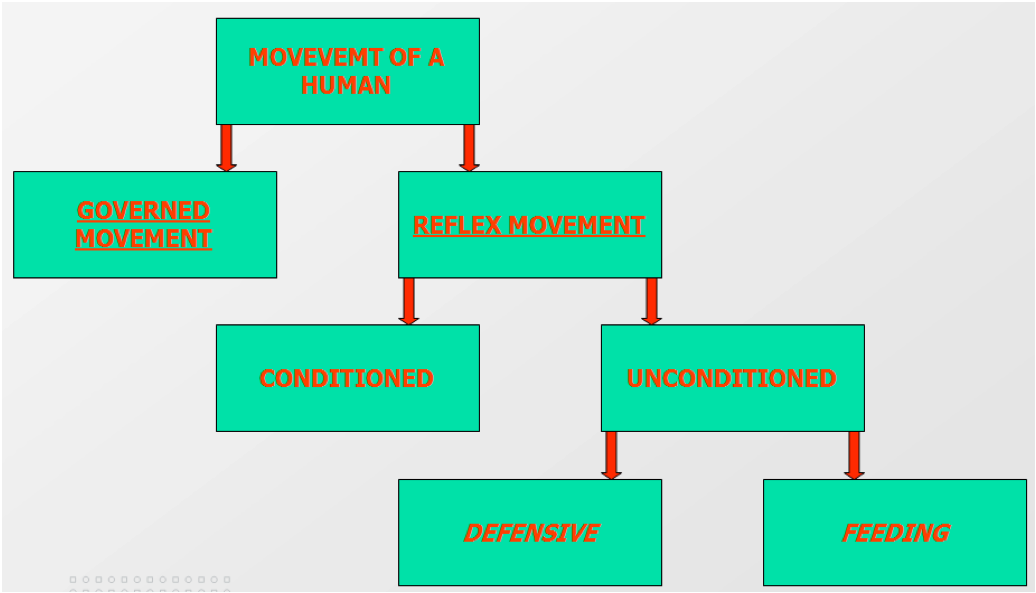
Theory of Physical Exercise (PE)
Fig. 3 Classification of human movements (Vobr, 2001)

Physical Exercise
Physical exercise means a systematically repeated locomotive units which are manifested in sports and physical education.
We distinguish among three aspects of physical exercise:
1) structural aspect - form
2) procedural aspect – action, development
3) final aspect - result
Structural Aspect - Form
a) Cyclicmovement (running, swimming, etc.) :
- fundamental stage (take-off, stroke,..)
- inter-stage (flight, transfer,..)
b) Acyclicmovement(hip-swing, throw, etc.):
- Preparatory stage (hollow hang, thrust-out,..)
- fundamental stage (stroke, throw-off,..)
- fade-out stage (support, landing,..)
c) Combinedmovement(javelin throw, high jump, etc.):
a combination of cyclic and acyclic movements
Example of cyclic movement (a video from the Olympics)

Example of acyclic movement (a video from the Olympics)

Example of combined movement (a video from the Olympics)

Procedural Stage – the process of motor learning
Procedural stage is closely connected to motor learning. There are some other important features within the process of motor learning:
a) Initial locomotive abilities, skills and qualities of locomotive system
b) The gymnast’s activity
c) Feedback
d) Docility: ability to learn new movements quickly and properly (the quality of acquiring new skills is possible to be measured by retention – retaining coordinate connections)
e) Interference: earlier coordinate connections affect creating new ones (tennis – table tennis)
f) Transfer: positive transfer of coordinate connections from one exercise to another (skating).
Important features: a) initial abilities of organism
b) the gymnast’s activity
c) feedback
Stages in Motor Learning
Within the procedural stage, gymnasts go through four stages of motor learning and the duration of individual stages depends mainly on docility. Thus, with some technical sports, this quality is crucial when selecting among new talents. The individual stages in motor learning are as follows:
1) Generalization Stage: introducing new locomotive task to the gymnast; it is connected to demonstration and subsequent attempts to carry out the task themselves. Initial attempts are usually guided, or with a large number of redundant movements respectively, which results in irradiation of the central nervous system (creating temporary connections in different areas of cerebral cortex). To complete this stage successfully, two features are necessary:
a) Broad sensory channel: utilizing as many analyzers as possible to become acquainted with the movement (demonstration, verbal instructions, slow motion video, moving the body during initial attempts, etc.)
b) Adequate motivation: from the point of view of motor learning efficiency, neither low motivation (the gymnast’s attitude to training is passive) nor high motivation (the gymnast is too taken with the movement, tries too hard and takes active part in the process of learning but is not able to think about the course of the movement itself) are preferred.
2) Differentiation Stage: training of locomotive skill is carried out by executing the movement repeatedly. Therefore, optimum conditions for training must be provided. Feedback (both internal and external) leads to fixing desired and effective movements. Thus, the movement is gradually being stored in locomotive memory in the form of locomotive program. Basically, it means creating a succession of conditioned reflex movements whose spatial and temporal execution is stored in memory.
3) Stability Stage: movement is executed automatically, in detail and fine coordination of all necessary movements. The movement is harmonic and improving is done with the aim of optimum performance in a competition. Training focuses on perfect execution under different conditions, different succession, under time and psychic pressure. Locomotive ability is stabilized and it is difficult to get over it.
4) Associative Stage: this stage is characterized by great plasticity of locomotive skills with regard to both internal and external conditions. Locomotive skills are utilized under changing conditions in competitive situations that is why the portion of cognitive processes which must be analyzed by the athlete during competition increases. This top stage significantly manifests anticipation of teammates’ and opponents’ behaviors. This anticipation makes it possible for some individuals to excel others – the highest stage of development of a talented athlete.
Final Aspect – result of physical exercise
Performance is the degree of implementing the locomotive task given.
Maximum performance: an individual may get closer to limit performance after long-term and systematic loading.
Efficiency: it is an ability to give best performance repeatedly during longer time period.
Limit performance: it is determined by somatic, physiological and mental preconditions of an individual.
The increase of energy output in relation to increasing performance of an individual is exponential. This is reflected in the creation of score charts – progressive score charts.
Table 1 Classificationof Sports Performance (Choutka, Dovalil, 1991)
